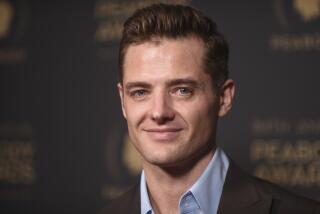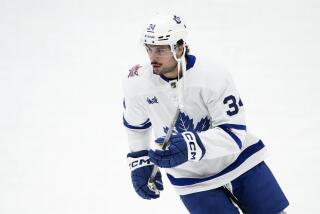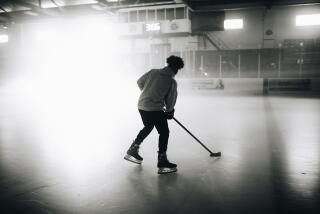OâRee, Who Integrated the NHL, Remains an Inspiration
Several years ago on a Boston ice rink, Jose Rojas stood between Bobby Orr and Willie OâRee, blew up his chest and smiled.
He doesnât have the photograph, but he remembers what it looks like. He remembers what the moment felt like.
Now 17, and with a fairly recent plan to graduate from Gilbert East High in Anaheim and then attend college, he understands why he was there.
âI believe in myself,â said Rojas, who lives in Anaheim. âI believe Iâll finish school. Iâm improving pretty good in school, and Iâm getting better in hockey. I think Iâm achieving.â
Disneyâs GOALS program--Growth Opportunities through Athletics, Learning and Service--didnât quite grab Rojas off the street and make him skate, but itâs not all that far from the truth, either.
At practically no cost, Rojas, along with 600 others, was given equipment and ice time and coaches and teammates and a whole new set of friends, many of them at the Disney Ice skating facility in Anaheim.
Two years into the program, at the Willie OâRee All-Star Hockey tournament in Boston, Rojas was introduced to OâRee. They shook hands. They posed for that photograph. OâRee told him his story, and Rojas had a new inspiration to go with his used skates and gloves.
âWhen I met him, it was like, âWhoa,â â Rojas said. âMy first thought was, âWhat if Iâm the first Hispanic to play in the NHL?â â
Last week, OâRee, who integrated the NHL, sat in a back booth at Albieâs Beef Inn, an old hockey playersâ hangout on San Diegoâs hotel circle. A photo of a young OâRee hung in the lobby.
âWhen I played in the NHL, there was no diversity in the league,â he said.
Actually, there was. It was him.
A black man from Fredericton, New Brunswick, OâRee broke hockeyâs color barrier on Jan. 18, 1958. He played two games for the Boston Bruins, then did not return to the NHL until the 1960-61 season, when he played 43 more games. The NHL didnât see its second black player until 1974.
OâRee played 21 years for 11 professional teams, including those 45 games in the NHL.
After more than 15 years out of hockey, all in San Diego, he is director of the NHL/USA Hockey Diversity Task Force. NHL rosters are 3% black. New Jersey Devil rookie Scott Gomez is the gameâs first Latin player.
At 64, and much like Rojas, OâRee has a new inspiration. Its name is Jose Rojas. And its name is Luis Sanchez, another member of Disneyâs program. And its name is Tony Lozano, still another GOALS player.
OâRee would not recognize them, probably. But he knows them. He knows their lives and the uncertainty of their dreams. He knows how much harder they work, the invisible pounds they carry on their backs.
âThese kids are just wanting a chance to play,â OâRee said. âSome of them have never held a hockey stick before. Theyâre just hungry to learn.â
OâRee reaches out to the children. He talks to them. He holds clinics. There is an All-Star weekend for youths in his name, held annually in different cities.
âI just tell them how it was,â OâRee said. âThe doors and the barriers have been down, 42 years ago [last week]. The prejudice and bigotry and ignorance and racism still exist, but itâs a little easier now. I just tell them they have to really believe in themselves, and that they have to like themselves.â
For Rojas, it helps to know that somebody has been there, that that somebody is a kind and generous man, and that he appreciates the hardships.
âSome people donât think I have a chance,â Rojas said. âI know nothing is promised. But Iâm going to give it everything Iâve got.â
Sanchez, 17, is a junior at Loara High. He, too, met OâRee in Boston. He admitted that in his early teens, âI was one of those little gangster guys.â
Now he wants to be the first in his family to go to college.
âHe gave me hopes,â Sanchez said of OâRee. âHe helped turn my life around. After I went to Boston, my life totally turned around. Now, when people say only a certain kind of person can do something, I think, âHey, you never know.â
âI believe in myself. I didnât. I totally didnât. Now I do.â
Lozano, a 15-year-old sophomore at Katella High, has been in Disneyâs program for nearly six years.
He met OâRee three years ago in Chicago, and heard him talk about, among other things, âgrowing up playing hockey, then being pushed around by white people.â
Lozano wants to play college hockey.
âI believe in myself,â he said.
If they sound like OâRee, it is by design. Of the 600 youths in GOALS, all but a handful are minorities.
OâRee understands. He left home after two years of high school in order to earn $60 a week playing junior hockey, a salary that bought his parents their first home.
Occasionally, OâRee will get a telephone call from a parent in Harlem. Or Detroit. Or Chicago. Someone called their son a terrible word. Someone started a fight because of the color of their sonâs skin. Someone swung a stick for no reason.
OâRee, too, suffered for the color of his skin. Lost teeth. A split lip. Hundreds of stitches. Horrible remarks that four decades later make OâReeâs jaw taut.
âI turned my ears off to all that,â he said. âI had to. Iâd have never survived 21 years. I really couldnât have survived. Iâll tell you, I never dropped my gloves because of a racial remark. But, you have to do what you have to do.
âI tell them that they really have to believe in themselves, to be proud of who they are. Thatâs the thing with a lot of these players of color, they have to be proud of who they are. They canât try to change the color of their skin, because they canât. If people donât want to accept them for who they are, then thatâs their problem.â
They make up a little ground every day, perhaps, at places like Disney Ice, one kid at a time. They make up a little ground at the Disney GOALS office, where a photograph shows Bobby Orr, a white man, with Willie OâRee, a black man, and Jose Rojas, a Latino and soon to be a man.
âItâs a good picture,â Rojas said.
More to Read
Go beyond the scoreboard
Get the latest on L.A.'s teams in the daily Sports Report newsletter.
You may occasionally receive promotional content from the Los Angeles Times.






